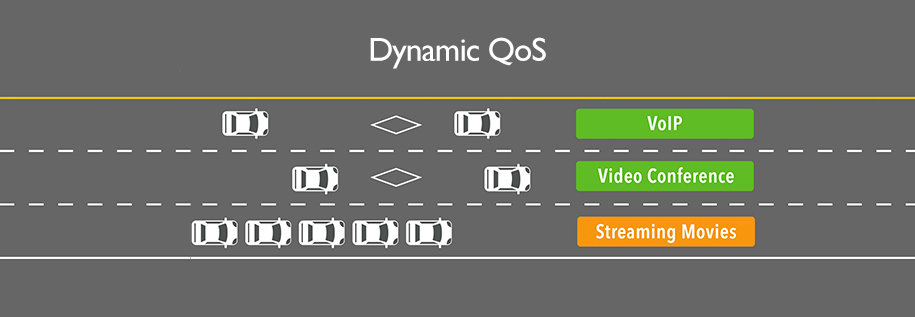SaaS, cloud, and internet technology users rejoice – thanks to Bigleaf Dynamic QoS, your business-critical applications will still perform seamlessly no matter what’s going on in the background.
Networking is a distinct territory within IT with equally distinct jargon to match. One term you’ve probably heard of is quality of service (QoS) – technology that controls network traffic to ensure the performance of essential applications.
Although quality of service is not a new concept, QoS and its latest variations are a hot topic regarding today’s SMB IT infrastructure. But what is Dynamic QoS, and how does it work? Is Dynamic QoS necessary for your business continuity and success?
Read on as we answer your questions, explain its business implications, and show real-world examples of what makes Bigleaf Dynamic QoS technology an absolute game changer for SMBs.
Let’s dive in.
What Is [Dynamic] QoS and how does it work?
In a nutshell, quality of service is a set of technologies or tools that manage and prioritize network traffic, ensuring the smooth, consistent performance of high-priority and real-time applications & traffic (even with limited internet capacity).
These days, business applications aren’t only competing with many types of internet traffic; the applications are competing with one another (whether you work from home or a corporate office). While all apps within a network are subject to the consequences of bandwidth issues and poor connection quality, apps with real-time requirements feel the effects fast – think crappy choppy video conferences and VoIP calls.
Internet disruptions like those aren’t just annoying for your teams and your customers. When meetings are interrupted or sales calls drop, operations are stalled, costing your business revenue, productivity, recovery & more. In fact, according to the latest data from Gartner, the average cost of network downtime or unusable uptime (when your internet is live but unstable) to your business is upwards of $300K per hour.
QoS mitigates these all-too-common connectivity and performance problems by working to reduce the effects of packet loss, latency, and jitter on a network, prioritizing and routing traffic through circuits in a way to best handle that of your business-critical apps such as Microsoft Teams, Zoom, RingCentral, and other SaaS and cloud-based tools for VoIP, video conferencing, and video-on-demand.
To put it simply, you can think of your internet connection as a massive, multi-lane freeway. When the flow of traffic starts to get heavy, QoS is like the carpool and bus-only lanes reserved for your high-priority apps, resolving traffic congestion.

Traditionally, QoS works by prioritizing packets based on manual policy and configuring routers that create separate virtual queues for each application. Bandwidth is reserved for the essential applications or websites that are assigned priority access. A network administrator usually allocates the order in which packets are handled and provides the appropriate level of bandwidth to each app or traffic flow.
If that sounds tedious and limiting, it’s because it is.
Plus, traditional solutions can only allocate bandwidth to internet traffic leaving the local network. Everything beyond the LAN is outside its control. So, traditional QoS solutions are helpful but, again, limited, especially in today’s work-from-anywhere business landscape.
Enter Dynamic QoS
Rather than using legacy, first-in-first-out (FIFO) methods, Dynamic QoS helps improve business-critical app performance by improving internet traffic management capabilities via bandwidth allocation and traffic prioritization techniques automatically. Instead of IT leaders or network administrators manually configuring QoS rules into your network, Dynamic QoS auto-adjusts traffic rules using intelligent software.
When your Dynamic QoS tools and other SD-WAN capabilities work cohesively, the way the health of your internet connection and bandwidth is monitored, managed, and prioritized ensures the silky-smooth performance of your much-needed business applications.
Whether you’re working in a household of hardcore gamers and streaming services junkies, or in a busy corporate office, Dynamic QoS recognizes and protects the services using minimum bandwidth + require low latency.
Since Dynamic QoS reduces disruptions caused by problems like downtime, latency, and jitter, your network automatically becomes more cost-effective. So, your business, by default, becomes more productive.
Is Dynamic QoS really beneficial for business?
In a word, yes. Without proper QoS, network data can become disorganized to the point of causing performance degradation or worse. As mentioned above, that’s a $300K per hour problem that most SMBs can’t weather.
And with Dynamic QoS, the identification and prioritization of traffic happen automatically, in real-time. So, you no longer need to spend time, and use staff or other resources to consistently monitor all the applications your business uses.
In general, QoS, especially Dynamic QoS, empowers businesses and end-users by ensuring the cloud and internet apps they rely on work optimally. Optimizing latency allows employees to be as productive and focused as possible while keeping users happy: no more dropped VoIP calls, video conferences, or VPN sessions.
Clearly, the benefits of QoS and its advanced, dynamic variant are integral to a thriving business. But are all services created equal? Not according to more than 100,000 users and counting who rely on Bigleaf Networks to provide them with truly reliable connectivity daily.
Why SMBs choose Bigleaf Dynamic QoS to intelligently prioritize internet traffic
“Bigleaf has architected a new kind of networking platform to deliver end-to-end connectivity to and from anywhere your traffic needs to go.”
Like other SD-WAN solutions, we do three things here at Bigleaf. We monitor connectivity, route your traffic, and prioritize it. However, the way we do it here uses intelligent software instead of manual policy and configuration work. So, our customers can simply plug into the Bigleaf service and reap the benefits of performant connectivity almost immediately.
Notably, the way we provide QoS prioritization across the public internet is unique even among other players in our industry. We can adapt to circuit conditions and bidirectionally control traffic over the internet to assure prioritization for your key applications. This means VoIP and video are always smooth, and those business-critical apps stay responsive even if other users in your network are downloading giant files.
Our Dynamic QoS also works on a single Internet connection. So, you can still enjoy all the prioritization, circuit monitoring, and proactive alerting benefits Bigleaf offers while sticking to one circuit.
Our self-driving AI approach utilizes Bigleaf Same-IP Failover and our patented Intelligent Load Balancing that all work together with our innovative Dynamic QoS technology to ensure your cloud applications are constantly performing.
The benefits and use cases of QoS, especially Bigleaf’s AI-driven, Dynamic QoS, are numerous and make implementation worth the investment for your growing business.
Dynamic QoS: You don’t need more speed, just better prioritization
Let’s check out a real-world scenario that may look close to a situation you’d find yourself in. It’s a perfect example of QoS prioritization in action.
Bigleaf Networks co-founder Joel Mulkey, an IT visionary, offers a quintessential example of the “less is more” approach.
View Graph A below.
At Joel’s home, the fastest circuit has about 6 Mbps of download speed. Recently, one of his kids purchased a brand-new video game from the digital distribution service Steam. Notice that the game was downloading during the day, saturating that circuit (red). Yet, throughout the day, that same circuit was the healthiest (in addition to being the fastest). So, our Intelligent Load Balancing placed Joel’s Zoom calls onto the path (green).
Notice how QoS slows down the lower priority bulk data during those periods, which kept Joel’s Zoom calls perfectly clear. Now that’s how you prioritize traffic on your internet connection, especially one with such limited bandwidth!
That’s the key value of Bigleaf’s AI-powered Dynamic QoS: it automatically identified the game as a type of traffic that shouldn’t have priority over a business-critical app like Zoom.
So, there was no need to notify IT of a new app running through his circuit, the team didn’t need to create a new policy, and Joel was able to stay focused and productive, completing his business tasks without distractions.

Now, this was at Joel’s home in the Northwest US. But whether you operate out of a home office or run a multi-site, multi-state enterprise, Bigleaf Networks’ site-to-cloud SD-WAN technology delivers consistency and performance you can count on
Imagine the same situation at a corporate office, where an employee might get invited to a video conference using an app that IT did not anticipate. Bigleaf Dynamic QoS recognizes that traffic and automatically prioritizes it, just as it would treat other VoIP and video call traffic.
Find more insights in Bigleaf’s customer success stories.
Dynamic QoS: Optimizing the internet for your business
At Bigleaf, we understand that when it comes to getting work done — no matter what internet provider you’re using, no matter your location, and no matter what kind of organization you run — if you rely on cloud and SaaS applications for business, they need to function optimally. So, we set out to create the most effective Dynamic QoS tools to help deliver the performance you need.
We provide AI-powered Dynamic QoS as a part of our SD-WAN solution to supercharge businesses throughout the USA and Europe, who need truly reliable internet connectivity for every application, every technology, every user, everywhere — over any ISP.
Learn how Bigleaf can transform your business for the better by requesting a FREE demo. If you have any questions, send us an email at sales@bigleaf.net.







